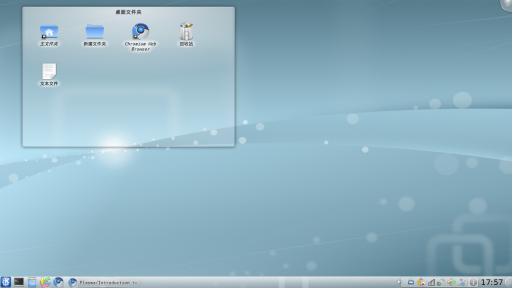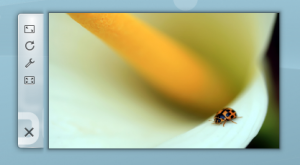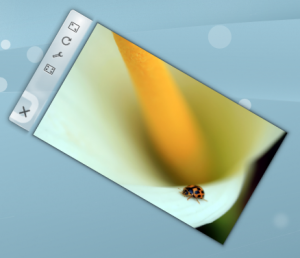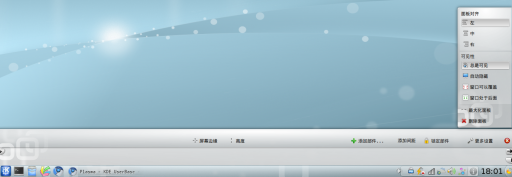Plasma(工作空間)
Template:I18n/Language Navigation Bar
介紹:Plasma是什麼? Plasma做什麼?
Plasma就是 KDE 軟體集(Software Compilation) 4 的桌面介面,包括了程式啟動器(開始菜單),桌面,桌面面板(經常簡稱為任務欄,儘管這只是面板的一個組件)。
Plasma 一覽
一個典型的Plasma桌面看起來像這樣:

一個 Plasma 桌面有三個關鍵組件:
- 面板,更常見的叫法是任務欄,提供放置程式啟動器,任務(程式)列表,時鐘和系統托盤的空間;
- 桌面,元件和圖示擺放的區域;
- Plasma工具箱位於屏幕右上角。面板右側也有一個。
使用 Plasma
你可以像使用其他任何操作系統那樣使用 Plasma,訪問程式菜單(K 菜單),查看任務欄上當前運行的程式,訪問系統托盤上的圖示等等。
Plasma一個重要的部分是被叫做元件的東西。元件是桌面上獨立單元(individual units),它們包括(不限於)程式菜單,圖示,系統托盤,時鐘...元件可以放置在桌面本身,或插入到面板。面板和桌面實際上是特殊類型的元件,能夠容納其他元件(在Plasma層面上來講,它們被稱作"容器Containments")。
那個怎麼跟桌面使用聯繫起來哪? Plasma也有關於傳統桌面使用的一些新特性。我們之前已經提到了 Plasma 工具箱(toolboxes),有時也被叫做"腰果(cashews)":那些是與Plasma交互,自定義Plasma的方式。點擊它們,屏幕會彈出一個帶多種選項的菜單:在那你可以添加元件到面板或桌面上,縮放、添加/刪除面板,和其他操作。
桌面和圖示
如你可能從截圖中註意到的,桌面上沒有直接放置圖示。而是,它們被放置在一個容器內,更常見的叫法是「文件夾視圖」。雖然有許多這樣做的技術上的原因,但「文件夾視圖」可以完美的作為桌面替代。 (實際上,它默認就是顯示「桌面」文件夾的內容)。你可以拖動它上面的圖示,剪切,複製,粘貼,重命名文件並且也能創建新文件夾/文件。
實質上與常規桌面文件夾的主要區別是這兩點:
- 你可以擁有多個文件夾視圖在桌面上;
- 你可以設定不同文件夾視圖顯示不同文件夾的內容(本地和網絡上的文件夾都可以)。
除了文件夾視圖,你可以擺放各種元件到桌面上,比如天氣預報元件,筆記元件,文件觀察器...隨你喜歡,沒有限制。
無處不在的元件
KDE SC 4.x中的Plasma不但支持Plasma專屬的元件(這類元件也叫做Plasmoid),也支持其他來源比如Google Gadgets和Mac OSX的Dashboard Widgets。額外的元件可以輕易的通過獲得百寶箱找到並安裝。
停靠在面板中的元件通常都有選項菜單,那些桌面上的元件在'把柄(handle)'上有配置選項,把柄是彈出的灰色區域,有時在元件右側,有時在元件左側。點擊按住把柄空餘部分允許你拖動元件到理想的位置。

在把柄上有四個工具。頂部那個是縮放。點擊並按住這個工具,你可以拖動放大和縮小。
第二個工具是旋轉工具。同樣的,點擊並按住它,旋轉到理想的角度。

第三個,把手或手柄樣的工具允許你設定當前這個元件的選項。
最後一個,第四個工具用在某些像是「照片相框」的元件上。例如如果你使用「照片相框」元 件,這個工具會打開「圖片瀏覽器」。
一些我們喜愛的元件在Plasma 元件頁面有所討論。
開始菜單
開始菜單等。
面板

可以點擊面板右側的「工具箱」打開設置模式設定面板。隨你喜好定義面板。
面闆對齊: 允許面板的準線以三種預設的位置設定。
總是可見: 保持面板總是可見,即使窗口最大化。
自動隱藏: 隱藏面板從屏幕上消失直到鼠標移到屏幕邊緣。
窗口可以覆蓋: 允許窗口可以覆蓋面板,如果窗口最大化,會覆蓋整個面板。
窗口處於後面: 允許窗口處於面板後面,即使窗口最大化。
最大化面板: 使面板最大化適應屏幕邊緣。
刪除面板: 移除當前面板。
鎖定元件: 鎖定面板合元件的位置。
添加間距: 允許你添加間距到面板上,為相鄰的部件間添加距離。
添加元件: 允許添加元件到面板上。
Height: Allows the panel height to be adjusted.
Screen Edge: Allows you to drag the panel to any of the four edges of the screen.

The arrows on the edge, just below the main settings allow the panel's size to be adjusted. Dragging the arrow makes the panel smaller or larger. Dragging the arrow pointing down, moves the panel's position.
Advanced usage
Special cases not covered here
Activities and the Zooming User Interface (ZUI)
KDE Plasma has brought a lot of new features to the modern linux desktop, however many people are only using a fraction of the desktop's full potential. One of the most useful and underused features is the plasma activities. The basic idea behind is that your desktop space is limited to how many widgets it can hold. A user will want to use a lot of widgets but doesn't want their desktop to be cluttered. The answer to this problem is activities; they allow you to specialize each desktop to whatever task you need to accomplish. To make a new activity you have to click on the toolbox in the upper right hand corner, from there click zoom out. The desktop will zoom out then click add new activity under the small desktop. It will make a new desktop right next to it. Now go click the zoom in button under the new desktop. With this desktop you can add whatever widgets to this desktop and it will not affect the other desktop.
Activities and Virtual Desktops
Virtual desktops, the ability to have a separate sets of windows on separate desktops, can tie in with Activities. You can have a different activity on each virtual desktop. In Plasma Desktop 4.4, this can be configured by entering System Settings and navigating to Desktop -> Multiple Desktops, and checking "Different Activity for Each Desktop".
In Plasma Desktop 4.3, You configure this by zooming out and choosing "configure Plasma". Then select "use a different activity on each desktop" and zoom in again.
Use Cases
A user likes web comics so they add their favorite web comics via the comics widget. The user now has a full desktop activity dedicated to their favorite web comics. Now the user is happy with the web comics, but the user now has to go to work, so the user creates a activity with the folder view widgets set to the folders of the projects the user is currently working on. After work the user goes home and works on a side project of writing romance novels. The user always gains inspiration by looking at pictures of the user's significant other. The user now creates a new Activity but now puts pictures frame widgets with pictures of the user's significant other. The user also has a folder view of the romance novel project folder. Now no matter what the user is doing the user has a custom tailored activity to match it.
Go to this blog to read a few tips on using activities.
Hints and Tips
The Taskbar
Accessing the Taskbar Settings Menu: Click the panel toolbox (aka cashew), then right-click on the taskbar. From there you can access the Taskbar Settings dialog. The following settings are particularly useful:
- Grouping and Sorting: Grouping can be by program name, manually, or not at all. (You can also choose to only enable grouping if the taskbar is full.) Similarly, Sorting defaults to alphabetically, but it can also be by desktop, manually, or not sorted.
- Only Show Tasks from the Current Desktop: A checkbox on the Filters section.
- Have More than One Row on the Taskbar: If you use many applications at one time you may find it advantageous to set Maximum Rows and then Force Row Settings.
- Showing or Hiding Tooltips: A simple checkbox in the Appearance section of the General page.
Tweaking Plasma
- Learn how to add a sidebar with clock and news
- Customize your Plasma by mixing multiple Plasma themes
Further information
- The Plasma FAQ
- Plasma HowTo - short screencasts
- Glossary
- Some of our favourite plamoids - why not add yours?
- Here's how to install more Plasmas widgets
- Learn the versatility of KRunner
| Back to the Introduction page |
